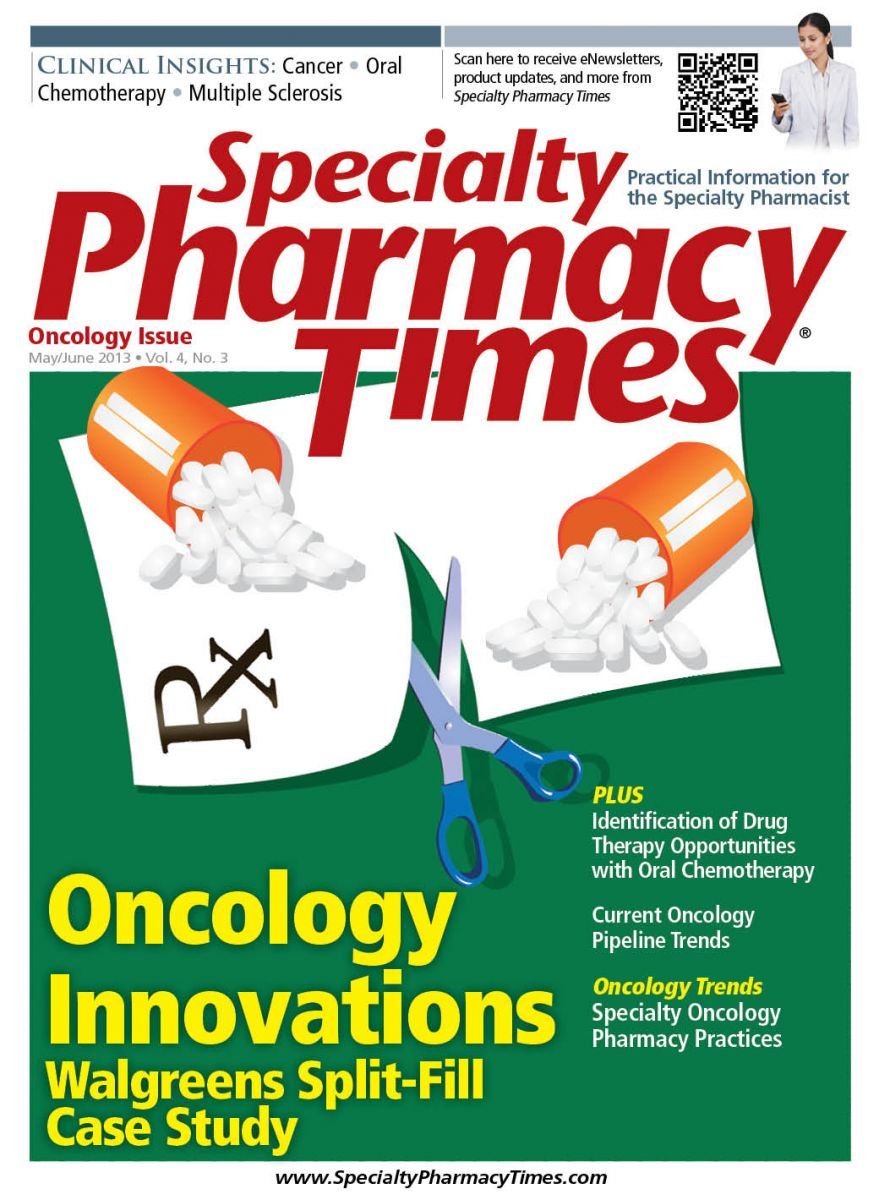Publication
Article
Specialty Pharmacy Times
Walgreens Split-Fill Case Study: Preventing Waste Through Extension of a Cost-Saving Program
As part of its pharmacist-driven ConnectedCare Oral Oncology Program, Walgreens Specialty Pharmacy recently conducted a unique 3-month monitored-dispense pilot program, which reflects continued innovation, additional cost savings, and improved health care system communication.
As part of its pharmacist-driven ConnectedCare Oral Oncology Program, Walgreens Specialty Pharmacy recently conducted a unique 3-month monitored-dispense pilot program, which reflects continued innovation, additional cost savings, and improved health care system communication.
Oral chemotherapy—an increasingly used method of cancer treatment—provides cost savings and significant quality of life benefits to patients.1 Despite its benefits, however, the treatment imparts challenges because patients take the medication at home and are not under the watchful eye of clinicians as they would be if they were receiving intravenous therapy. Patients are therefore more likely to take medications incorrectly, or stop them altogether due to side effects.1
Pharmacists have stepped in to fill the gap in oversight, providing patient monitoring and counseling, and serving as a bridge between patients and physicians. As part of its pharmacist-driven ConnectedCare Oral Oncology program, Walgreens Specialty Pharmacy recently conducted a unique 3-month monitored-dispense (split-fill) pilot program. Building on an extensive, patient-centric program, the pilot reflects continued innovation, additional cost savings, and improved health care system communication.
High-Touch Patient Care
Walgreens Specialty Pharmacy manages 27 oral chemotherapy specialty medications, supported by our ConnectedCare Oral Oncology program, which provides high-touch patient care on a continuum based on patient need and clinical current status. All patients who receive their oral chemotherapy through Walgreens Specialty Pharmacy are provided this care, which, at a minimum, also includes patient education and an extensive initial assessment prior to the start of therapy, as well as an additional assessment in the first month, and once-a-month assessments for the course of treatment. Conducted by pharmacy clinicians, assessments include compliance and refill reminders, adherence monitoring, side effect counseling and management, clinical data collection, and review of the medication profile for potential interactions.
A subset of ConnectedCare Oral Oncology patients—those who are prescribed 11 oral chemotherapy medications with a known high drop-off rate—are included in the Walgreens Specialty Pharmacy Cycle Management Program (CMP) and receive an additional assessment the first month. Those medications include sorafenib, sunitinib, erlotinib, everolimus, pazopanib, dasatinib, nilotinib, bexarotene, vorinostat, bosutinib, and regorafenib.1
Additionally, patients who take these high drop-off drugs (other than bosutinib and regorafenib), and whose insurance providers support the option, are eligible for the Walgreens split-fill program. The split-fill program prevents medication waste by providing a half-month’s worth of the medication at a time, rather than a full month. Many oral chemotherapy patients stop taking their medication long before the monthly supply is depleted, typically due to intolerable side effects or lack of therapeutic benefit. In the program, the patient receives a 14- or 16-day supply of the chemotherapy.1 If the patient tolerates and is able to continue with the chemotherapy, the remaining half-month of the prescription is filled.
Best in Class
Walgreens CMP was named best in class by an independent consulting firm, and early results of an ongoing analysis demonstrate the program’s benefit due to the patient assessment and split-fill features.1 The average potential direct savings for the payer from avoiding medication wastage is more than $934 per patient who discontinued use in the first month of therapy.1 Because Walgreens pharmacists are available to help address adverse effects, patients in the program are less likely to visit the emergency department. Researchers estimate the probability of reduced hospital admission saves an average of $440 per patient.1 The combination of direct and indirect savings adds up to more than $1300 per patient, potentially resulting in multi-millions in savings when projected to a larger patient population.
Initially, the split-fill option was available only in the first month of treatment, but after analyzing the data, Walgreens realized that some patients were able to take their medication for the first month, but stopped taking it in the first half of the second or third month. Walgreens launched a pilot program to determine whether the split-fill option would be valuable if applied to months 2 and 3 as well.
Split-Fill Case Study
The pilot program included 50 patients who were members of a large regional insurance plan in the Northwest. During the first 3 months, Walgreens filled the prescriptions twice a month (rather than once a month). After the initial pre-therapy assessment, pharmacists continued to assess the patients twice each month—once in the middle of the month and once at the end, around the time of the refills.
From July to December 2012, Walgreens tracked outcomes and 11 of the 50 patients stopped taking their medications at some point in the first half of the dispensed month during the expanded 3-month splitfill program: 5 stopped in the first half of the first month, 3 in the first half of the second month, and 3 in the first half of the third month. After 3 months, the 39 patients remaining on their initial therapy received monthly refills and assessments.
Of those who discontinued therapy in the first 3 months: 29% did so due to challenging side effects; 29% had died; 14% transitioned to hospice care; 14% had a change in insurance to a company that did not support the split-fill option; and 14% had their therapy discontinued by their physicians for unknown reasons. By extending the split-fill program to 3 months for those patients, the insurer saved 5% of the total monthly specialty oncology drug spend on those patients. That is significant, as a 1-month prescription for these medications is typically about $10,000. Preventing $5000 a month in unnecessary spending per patient can add up quickly.
Potential Savings
Walgreens tracks potential savings in all patients prescribed any of the 9 potential split-fill medications, even if the payer does not support the option. Walgreens reports data on a quarterly basis to those insurers regarding the savings they would have accrued had they supported the splitfill option. In light of those reports, several payers have begun supporting the split-fill program.
Walgreens continues to look for innovative opportunities to better serve patients and help customers save costs. Extending the split-fill option to 3 months is an example of such an enhancement. As more oral chemotherapy medications are approved, Walgreens will continue to assess whether they should be included in the CMP and split-fill programs.
References
1. Walgreens data on file
About the Authors
Mike Ellis, BSPharm, is corporate vice president, specialty pharmacy and infusion for Walgreens. Before joining Walgreens in October of 2011, he served as the senior vice president of specialty trade relations and contracting and pharmaceutical services for CVS Caremark. His more than 29 years of experience covers both the specialty pharmacy and infusion services industries, including senior positions with companies including AdvancePCS, Olsten Health Services, Caremark, CVS, and Quantum Health Resources. Ellis is a licensed pharmacist and earned his bachelor of science in pharmacy from the University of Arkansas, College of Pharmacy.Richard T. Miller, RPh, MBA, is the director, specialty clinical services for Walgreens Specialty Pharmacy, based in the Carnegie, Pennsylvania office. He has more than 20 years of experience in pharmacy practice and health care management, working on a wide variety of projects involving pharmacy operations in retail, specialty, institutional, and industry pharmacy settings. In his current role, Rick is responsible for managing clinical program content, development, and strategy; clinician and patient education programs; oversight of the Walgreens Specialty Pharmacy — Duquesne University PGY1 residency program; and specialty pharmacy pipeline analysis, with all responsibilities focusing on improving clinical outcomes and the quality of life of Walgreens Specialty Pharmacy patients. Rick holds an MBA from the University of Florida Warrington College of Business Administration as well as a BS in pharmacy from the University of Florida College of Pharmacy and a Master Certificate in Six Sigma – Healthcare from Villanova University. Rick is currently a registered pharmacist in Pennsylvania, Florida, Virginia, and Illinois.







